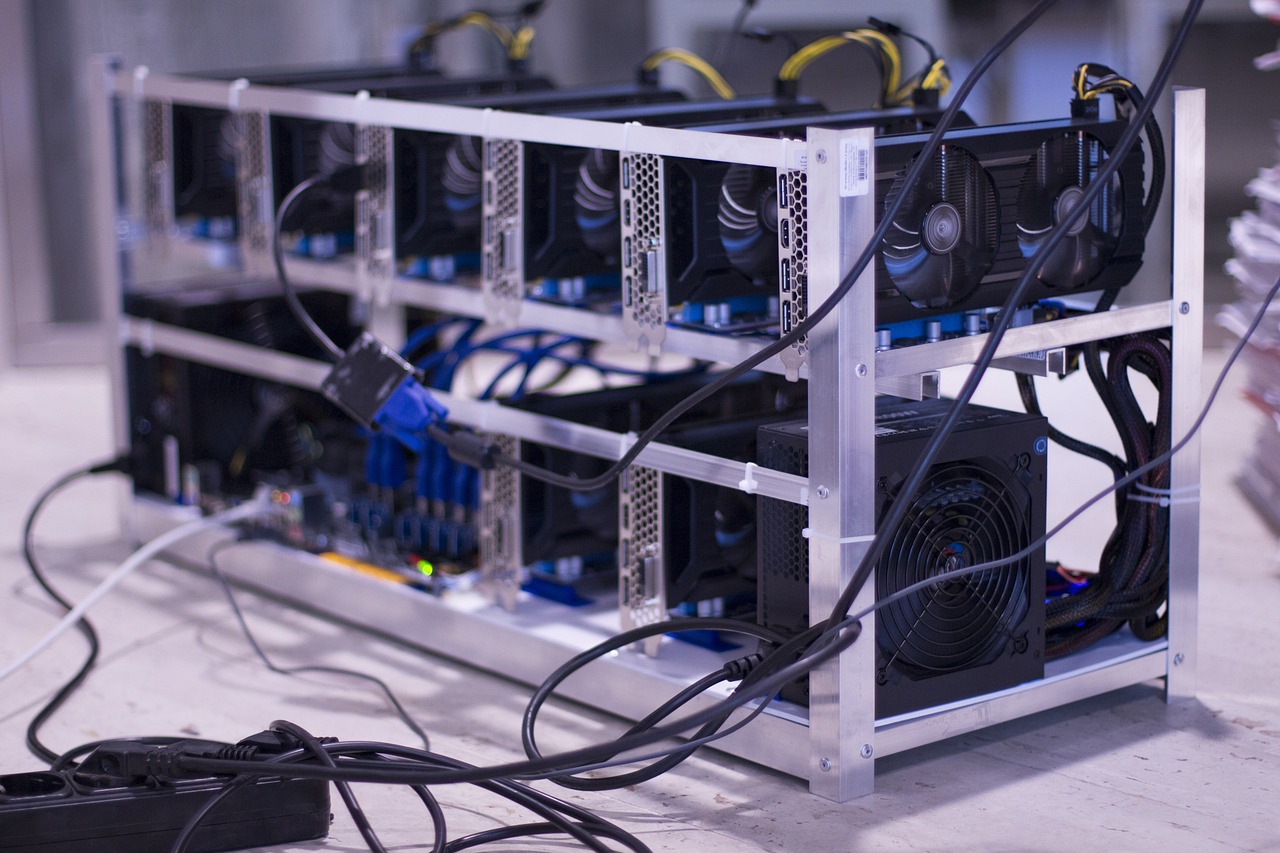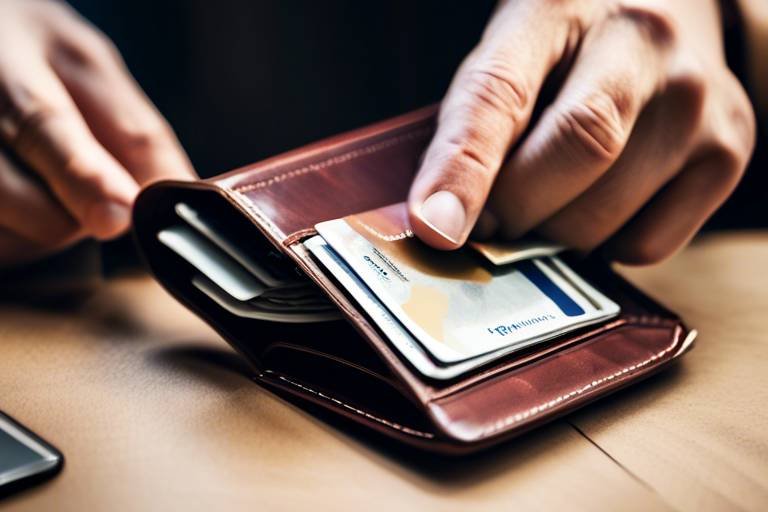The Future of Exchange Security - What’s Next?
The digital landscape is evolving at a breathtaking pace, and with it, the security of exchanges is becoming a hot topic. As more people engage in online transactions, the importance of safeguarding these platforms cannot be overstated. Imagine a bustling marketplace where every transaction is at risk of being intercepted by a thief lurking in the shadows. This is the reality of today's exchanges, where the stakes are high, and the threats are ever-present. So, what does the future hold for exchange security? Are we ready to tackle the challenges that lie ahead?
To navigate this complex terrain, we must first understand the nature of the threats that are emerging. Cybercriminals are becoming increasingly sophisticated, employing advanced tactics that can bypass traditional security measures. The rise of ransomware, phishing attacks, and other malicious activities poses a significant risk to both exchanges and their users. As a result, the industry must stay one step ahead, continually adapting to these new challenges.
But it's not all doom and gloom! The future of exchange security is also bright, thanks to innovative technologies that are reshaping the way we protect our digital assets. From blockchain to artificial intelligence, these tools are not just buzzwords; they represent a paradigm shift in how we think about security. By leveraging these technologies, exchanges can enhance their defenses and create a more secure environment for users.
As we delve deeper into this topic, we'll explore the various facets of exchange security, examining the emerging threats, groundbreaking technologies, and the evolving regulatory landscape. By understanding these elements, we can better prepare for the future and ensure that our digital transactions remain safe and secure.
As digital exchanges grow, so do the risks. The increasing sophistication of cyber threats targeting exchanges poses a significant challenge to the industry. Imagine a hacker, armed with the latest tools and techniques, stealthily infiltrating an exchange's security system. The potential impact on users and the industry is staggering, as breaches can lead to financial losses, compromised personal information, and a loss of trust in the platform.
Cyber threats are not just a passing phase; they are evolving and becoming more complex. Here are some key points to consider:
- Ransomware Attacks: Cybercriminals are increasingly using ransomware to hold exchanges hostage, demanding payment to restore access.
- Phishing Schemes: These deceptive tactics trick users into revealing sensitive information, leading to unauthorized access to accounts.
- Distributed Denial-of-Service (DDoS) Attacks: By overwhelming an exchange's servers, attackers can cause significant downtime and disrupt operations.
Understanding these threats is crucial for exchanges to develop effective strategies to combat them. The stakes are high, and the consequences of inaction can be devastating.
New technologies are revolutionizing exchange security, providing innovative solutions to combat the ever-growing threats. Among these, blockchain technology stands out as a game-changer. By offering transparency and security, blockchain can enhance trust in exchange transactions. Picture a decentralized ledger where every transaction is recorded immutably; this minimizes fraud and unauthorized access, creating a safer environment for users.
Blockchain technology is not just a buzzword; it is a powerful tool that can transform how exchanges operate. Its decentralized nature means that there is no single point of failure, making it significantly harder for hackers to compromise an exchange. Additionally, the transparency that blockchain provides allows users to verify transactions independently, fostering trust and confidence.
Smart contracts are another innovative solution that can enhance exchange security. By automating agreements, they reduce the risk of human error and ensure that transactions are executed as intended. Imagine a world where contracts are self-executing, eliminating disputes and enhancing compliance. This technology can secure transactions and bolster overall security measures in exchange operations.
Decentralized Finance (DeFi) platforms are challenging traditional exchanges by offering enhanced protection and user control over assets. With DeFi, users can engage in transactions without relying on a central authority, thereby reducing the risk of hacks and fraud. This shift in paradigm empowers users, allowing them to take charge of their financial destiny.
Artificial Intelligence (AI) and machine learning are also transforming security protocols in exchanges. These technologies enable the detection of anomalies and the prediction of potential threats, acting as a proactive defense mechanism. Imagine having a virtual security guard that learns and adapts to new threats, ensuring that your assets remain protected at all times.
As technology evolves, so do the regulations governing exchange security. Understanding these changes is vital for exchanges to ensure compliance and protect user assets and data. Regulatory bodies worldwide are tightening their grip on the industry, pushing for stronger security measures to safeguard users.
Different countries are approaching exchange security in various ways, creating a complex regulatory landscape. Some nations are leading the charge with stringent regulations, while others are still catching up. Navigating this global regulatory environment is crucial for exchanges operating internationally, as non-compliance can lead to severe penalties and loss of user trust.
Adopting best practices for compliance is essential for exchanges. Effective strategies include conducting regular security audits, implementing robust KYC (Know Your Customer) protocols, and fostering a culture of security awareness among employees. By prioritizing compliance, exchanges can navigate the regulatory landscape while ensuring that robust security measures are in place.
Q: What are the main cyber threats facing exchanges today?
A: The main threats include ransomware attacks, phishing schemes, and DDoS attacks, all of which can compromise user security and trust.
Q: How does blockchain technology enhance exchange security?
A: Blockchain provides transparency and decentralization, making it harder for hackers to compromise an exchange and allowing users to verify transactions independently.
Q: What role do regulatory changes play in exchange security?
A: Regulatory changes push exchanges to adopt stronger security measures, ensuring the protection of user assets and data in an evolving digital landscape.

The Rise of Cyber Threats
As the digital landscape continues to expand, the risks associated with online exchanges are escalating at an alarming rate. With an increasing number of users flocking to these platforms, cybercriminals are becoming more sophisticated, developing new tactics to exploit vulnerabilities. Just think about it: the more popular an exchange becomes, the more it attracts not just legitimate users, but also those with malicious intentions. The potential impact on users and the industry as a whole can be devastating.
Cyber threats targeting exchanges come in various forms, each with its own unique challenges. From phishing attacks that trick users into revealing sensitive information, to DDoS attacks that overwhelm servers and disrupt services, the landscape is fraught with danger. For instance, in 2022 alone, the cryptocurrency industry witnessed a staggering increase in hacking incidents, with losses totaling over $3 billion globally. This statistic is not just a number; it represents countless individuals and businesses affected by the fallout from these breaches.
Moreover, the rise of ransomware attacks has added another layer of complexity to exchange security. Cybercriminals are not just targeting exchanges for direct theft; they are also holding systems hostage, demanding exorbitant ransoms in exchange for restoring access. This trend highlights the need for exchanges to adopt a proactive stance in their security measures. The question we must ask ourselves is: how can we stay one step ahead of these ever-evolving threats?
To truly understand the gravity of the situation, we must consider the implications of these cyber threats. Users often place their trust in exchanges, believing that their assets are safe. However, when breaches occur, the consequences can be dire:
| Type of Threat | Potential Impact |
|---|---|
| Phishing Attacks | Loss of personal information and funds |
| DDoS Attacks | Service disruption, loss of user trust |
| Ransomware | Inaccessibility to funds, operational shutdown |
As we navigate this treacherous terrain, it's essential for exchanges to not only recognize these threats but also to implement robust security measures. After all, the safety of user assets and data hinges on the ability of exchanges to adapt and respond to these challenges. The future of exchange security will depend on a collective effort to bolster defenses and stay ahead of cybercriminals. Are we ready to take on this challenge?
- What are the most common cyber threats to exchanges? The most common threats include phishing attacks, DDoS attacks, and ransomware.
- How can exchanges protect themselves against these threats? Implementing advanced security protocols, user education, and regular system updates are crucial.
- What role do regulations play in exchange security? Regulations help establish a framework for security practices, ensuring that exchanges prioritize user protection.

Innovative Security Technologies
The digital landscape is constantly evolving, and with it, the need for robust security measures in exchange platforms. As cyber threats grow more sophisticated, innovative technologies are stepping up to the plate, offering solutions that not only enhance security but also redefine how we approach digital transactions. One of the most exciting advancements is the integration of blockchain technology, which provides a transparent and secure framework for exchanges. By utilizing decentralized ledgers, blockchain minimizes the risks associated with fraud and unauthorized access, ensuring that transactions are not only secure but also verifiable.
Imagine a world where every transaction is recorded on an immutable ledger, visible to all but alterable by none. This is the promise of blockchain, and it’s not just a pipe dream. In practice, it means that users can trust the integrity of their transactions without needing to rely solely on intermediaries. Additionally, the advent of smart contracts takes this a step further by automating agreements, which reduces the potential for human error. These self-executing contracts ensure that terms are met and compliance is maintained, adding another layer of security to exchange operations.
Smart contracts are like digital vending machines: you put in your input, and if everything checks out, you get your output without any fuss. They are programmed to execute automatically when certain conditions are met, which not only speeds up transactions but also minimizes the risk of fraud. For instance, in an exchange setting, a smart contract can ensure that funds are only released when both parties fulfill their obligations, thereby reducing the likelihood of disputes. This automation not only enhances security but also improves user experience by providing faster transaction times and reducing costs associated with traditional contract enforcement.
Another groundbreaking development is the rise of Decentralized Finance (DeFi) platforms. These platforms challenge the traditional centralized exchanges by offering users greater control over their assets. With DeFi, users can engage in trading, lending, and borrowing without the need for intermediaries, significantly reducing the risk of centralized points of failure. However, this shift also brings its own security implications. While DeFi platforms can enhance protection through user control, they also require users to take on more responsibility for their own security. Understanding how to navigate this landscape is crucial for users looking to protect their investments.
Moreover, the integration of Artificial Intelligence (AI) and Machine Learning into security protocols is revolutionizing how exchanges protect themselves against cyber threats. These technologies are capable of analyzing vast amounts of data in real-time, detecting anomalies, and predicting potential threats before they can cause harm. Imagine having a security system that learns and adapts, getting smarter with each interaction. This proactive approach not only enhances defenses but also provides peace of mind for users, knowing that their assets are being monitored by cutting-edge technology.
In summary, the future of exchange security lies in the hands of innovative technologies like blockchain, smart contracts, DeFi, AI, and machine learning. These advancements are not just buzzwords; they represent a significant shift in how we secure digital transactions. As these technologies continue to evolve, they will play an integral role in shaping the landscape of exchange security, ensuring that users can trade with confidence and peace of mind.
- What is blockchain technology?
Blockchain technology is a decentralized digital ledger that records transactions across many computers in a way that the registered transactions cannot be altered retroactively, ensuring security and transparency.
- How do smart contracts work?
Smart contracts are self-executing contracts with the terms of the agreement directly written into code, allowing for automatic execution when conditions are met.
- What are the benefits of using DeFi platforms?
DeFi platforms offer users greater control over their assets, eliminate the need for intermediaries, and can provide enhanced security through decentralized systems.
- How does AI improve exchange security?
AI improves exchange security by analyzing data to detect anomalies and predict potential threats, allowing for quicker responses to cyber attacks.

Blockchain Technology
Blockchain technology is often hailed as a revolutionary force in the world of finance and digital transactions. At its core, blockchain is a decentralized ledger that records transactions across many computers in such a way that the registered transactions cannot be altered retroactively. This feature not only enhances security but also builds trust among users. Imagine a public library where every book represents a transaction; once a book is placed on the shelf, it cannot be taken away or altered without everyone noticing. This transparency is what makes blockchain so appealing for exchanges.
One of the most significant advantages of blockchain technology is its ability to minimize fraud. In a traditional centralized exchange, a user must trust the institution to handle their assets securely. However, with blockchain, the need for such trust diminishes because every transaction is recorded and visible to all participants in the network. This creates a system where fraud becomes exceedingly difficult, akin to trying to cheat in a game where every move is recorded in real-time for all to see.
Moreover, blockchain enables the use of smart contracts, which are self-executing contracts with the terms of the agreement directly written into code. These contracts automate the execution of transactions when certain conditions are met, significantly reducing the potential for human error. For instance, if a user wants to exchange cryptocurrency for a service, a smart contract can automatically execute the transaction once the service is confirmed, ensuring that both parties fulfill their obligations without the need for intermediaries.
Another exciting aspect of blockchain is its role in the burgeoning field of Decentralized Finance (DeFi). DeFi platforms leverage blockchain technology to provide financial services without the need for traditional banks or intermediaries. This shift not only empowers users by giving them more control over their assets but also enhances security. With DeFi, users can engage in lending, borrowing, and trading directly from their wallets, reducing the risks associated with centralized exchanges, such as hacks and mismanagement of funds.
In summary, blockchain technology is more than just a buzzword; it represents a fundamental shift in how we think about security and trust in digital transactions. By decentralizing control and enhancing transparency, blockchain is paving the way for a more secure and trustworthy exchange ecosystem. As we move forward, the integration of blockchain into exchange security strategies will likely become not just beneficial but essential for protecting user assets and fostering confidence in digital transactions.
- What is blockchain technology? - Blockchain technology is a decentralized digital ledger that records transactions across multiple computers, ensuring that registered transactions cannot be altered retroactively.
- How does blockchain enhance security? - By providing transparency and immutability, blockchain minimizes the risk of fraud and unauthorized access, making it a more secure option for exchanges.
- What are smart contracts? - Smart contracts are self-executing contracts with the terms written into code, allowing automatic execution of agreements when conditions are met.
- What is Decentralized Finance (DeFi)? - DeFi refers to financial services that operate on blockchain technology without the need for traditional banks, giving users more control over their assets.

Smart Contracts
In the world of digital transactions, are rapidly becoming a game-changer. Imagine a contract that executes itself automatically when certain conditions are met. This is the essence of smart contracts, which are built on blockchain technology. They remove the need for intermediaries, streamline processes, and significantly reduce the chances of human error. This not only enhances efficiency but also builds trust among users, as the terms of the agreement are transparent and immutable.
Smart contracts function like vending machines: you insert the right amount of coins (or fulfill the contract conditions), and you get your product (or the contract executes). This automated nature ensures that once a smart contract is deployed, it operates independently without the risk of manipulation or interference. For exchanges, this means that transactions can be completed swiftly and securely, with minimal risk of fraud.
Moreover, the integration of smart contracts into exchange operations can bolster compliance with regulatory requirements. By automating processes, exchanges can ensure that every transaction adheres to the necessary legal frameworks without the need for constant oversight. This not only saves time but also reduces operational costs, allowing exchanges to focus on enhancing their services.
However, while the benefits are numerous, it's crucial to understand that smart contracts are not without their challenges. Issues such as coding errors, which can lead to vulnerabilities, and the need for robust security measures to protect against external threats are paramount. Therefore, exchanges must invest in rigorous testing and auditing of their smart contracts to ensure their reliability and security.
In conclusion, smart contracts represent a significant leap forward in enhancing security and efficiency in exchange operations. By automating transactions and ensuring compliance, they empower users and foster a safer trading environment. As the technology continues to evolve, we can expect smart contracts to play an increasingly vital role in the future of exchange security.
- What are smart contracts? Smart contracts are self-executing contracts with the terms of the agreement directly written into code, enabling automated and secure transactions.
- How do smart contracts enhance security? They reduce the need for intermediaries, minimize human error, and ensure that transactions are executed only when predefined conditions are met.
- Are smart contracts completely secure? While they offer significant security benefits, they can still be vulnerable to coding errors and external threats, necessitating thorough testing and auditing.
- Can smart contracts be modified after deployment? Generally, smart contracts are immutable once deployed, which is a key feature for ensuring trust, but some can include mechanisms for updates under certain conditions.

Decentralized Finance (DeFi)
Decentralized Finance, commonly known as DeFi, is not just a buzzword; it's a revolutionary shift in how we think about finance and exchanges. Imagine a world where you don't have to rely on banks or centralized institutions to manage your money. DeFi platforms are making this a reality by utilizing blockchain technology to create a more open and accessible financial system. But what does this mean for security? Well, it’s a double-edged sword.
On one hand, DeFi offers enhanced protection and user control over assets compared to traditional centralized exchanges. By eliminating intermediaries, users can conduct transactions directly with one another, significantly reducing the risk of hacks that often target centralized platforms. However, this new freedom comes with its own set of challenges. The very nature of DeFi means that users are responsible for their own security, which can be daunting for those who are not tech-savvy.
To understand the security implications of DeFi, consider the following key aspects:
- Smart Contracts: These self-executing contracts with the terms of the agreement directly written into code can automate transactions. While they reduce human error, they are only as secure as the code they are built on. Bugs or vulnerabilities in smart contracts can lead to significant financial losses.
- Liquidity Pools: DeFi platforms often use liquidity pools to facilitate trades. While this decentralization can enhance security, it also means that users must be vigilant about the protocols they choose to engage with, as poorly designed pools can be susceptible to exploits.
- User Education: With great power comes great responsibility. Users must educate themselves about the risks associated with DeFi, including the potential for scams and the importance of securely managing their private keys.
Moreover, DeFi is constantly evolving, and with it, the security measures must also adapt. Innovations such as insurance protocols are emerging to protect users from losses due to hacks or smart contract failures. These protocols act as a safety net, providing users with peace of mind as they navigate the sometimes-turbulent waters of decentralized finance.
In conclusion, while DeFi presents exciting opportunities for financial freedom and innovation, it also poses unique security challenges that users must be aware of. As the landscape continues to evolve, staying informed and proactive about security measures will be essential for anyone looking to participate in this new era of finance.
- What is DeFi? DeFi stands for Decentralized Finance, a financial system built on blockchain technology that allows users to conduct transactions directly without intermediaries.
- How does DeFi enhance security? By removing centralized entities, DeFi reduces the risk of hacks that typically target traditional exchanges, allowing users to have more control over their assets.
- What are the risks associated with DeFi? Users must be cautious of smart contract vulnerabilities, scams, and the importance of securely managing their private keys.

AI and Machine Learning
As we dive into the world of AI and machine learning, it's crucial to understand how these technologies are reshaping the landscape of exchange security. Imagine a vigilant security guard who never sleeps; that's what AI can be for digital exchanges. With the ability to analyze vast amounts of data at lightning speed, machine learning algorithms can detect anomalies that might indicate a cyber threat. This proactive approach is like having a crystal ball that can predict potential attacks before they happen, allowing exchanges to bolster their defenses preemptively.
The integration of AI into security protocols is not just a trend; it's becoming a necessity. Traditional security measures often rely on static rules that can be easily bypassed by sophisticated cybercriminals. In contrast, AI-driven systems learn from past behaviors, adapting and evolving to recognize new patterns of attack. For instance, if a user suddenly tries to withdraw a large sum of money from a location that is unusual for them, AI can flag this activity for further investigation. This kind of intelligent monitoring is essential in today’s ever-changing digital landscape where threats are constantly evolving.
Moreover, the application of machine learning extends beyond just detecting threats. It can also automate responses, significantly reducing the time it takes to react to potential breaches. Imagine a scenario where a cyber attack is detected; instead of waiting for human intervention, the system can automatically initiate countermeasures, such as locking accounts or alerting users. This swift action can be the difference between a minor incident and a full-blown security breach.
To illustrate the impact of AI and machine learning on exchange security, consider the following table that outlines key benefits:
| Benefit | Description |
|---|---|
| Real-time Monitoring | AI continuously analyzes transactions, identifying suspicious activities instantly. |
| Predictive Analysis | Machine learning algorithms predict potential threats based on historical data. |
| Automated Responses | Systems can autonomously react to threats, minimizing damage and response time. |
| Enhanced User Experience | AI can personalize security measures based on individual user behavior, improving usability. |
In conclusion, the fusion of AI and machine learning into exchange security is not just about keeping up with the latest tech trends; it's about creating a safer environment for users. As digital transactions continue to grow, so too will the sophistication of threats. By harnessing the power of AI, exchanges can stay one step ahead of cybercriminals, ensuring that users' assets and data remain secure. The future of exchange security is bright, and AI is at the forefront of this transformation.
- What is the role of AI in exchange security? AI helps in real-time monitoring, anomaly detection, and automating responses to threats.
- How does machine learning enhance security protocols? Machine learning algorithms adapt to new threats by learning from historical data and user behavior.
- Can AI predict cyber threats? Yes, AI can analyze patterns and predict potential threats before they occur.
- What are the benefits of automated responses in security? Automated responses can significantly reduce the time to react to threats, minimizing potential damage.

Regulatory Changes and Compliance
As the landscape of digital exchanges continues to evolve, so too does the regulatory framework that governs them. Regulatory changes are not just a formality; they are essential for ensuring the safety and security of users' assets and data. In an environment where cyber threats are rampant, regulations are becoming increasingly stringent, pushing exchanges to adopt robust compliance measures. But what does this mean for the average user? Well, it means that you can expect a higher level of protection and accountability from the platforms you choose to use.
One of the most significant shifts in regulation has been the move towards global harmonization. Countries are beginning to recognize the need for a cohesive approach to digital asset regulation. This is crucial because the digital economy knows no borders. For instance, regulations in Europe may impact exchanges operating in Asia or North America. Understanding these global regulatory trends is vital for both users and operators alike. A unified regulatory framework can help mitigate risks and enhance the overall security of exchanges.
Moreover, compliance is not merely about adhering to laws; it also involves implementing best practices that can significantly enhance security measures. For exchanges, this means investing in technology and processes that help them stay ahead of the compliance curve. By adopting effective compliance strategies, exchanges can ensure they are not only meeting current regulations but are also prepared for future changes. This proactive approach can make a world of difference in safeguarding user information and assets.
To illustrate the importance of compliance, consider the following table that outlines key regulatory developments affecting exchange security:
| Region | Regulatory Body | Key Focus Areas | Impact on Exchanges |
|---|---|---|---|
| Europe | European Securities and Markets Authority (ESMA) | Investor protection, market integrity | Increased reporting requirements |
| United States | Securities and Exchange Commission (SEC) | Security classification, anti-fraud measures | Stricter compliance checks |
| Asia | Financial Services Agency (FSA) | AML/CFT regulations | Enhanced KYC processes |
This table highlights how regulatory bodies across different regions are focusing on various aspects of exchange operations. As regulations tighten, exchanges must adapt or risk facing penalties that could jeopardize their business. Compliance is not just a legal obligation; it is a strategic advantage in a competitive marketplace.
In conclusion, the regulatory landscape for digital exchanges is in a state of flux, but this presents an opportunity for growth and improvement. By staying informed and compliant, exchanges can not only protect their users but also position themselves as leaders in the industry. The future of exchange security relies heavily on how well these platforms navigate the complex web of regulations while ensuring the utmost protection for their clients.
- What are the main regulatory bodies overseeing exchanges?
Key regulatory bodies include the SEC in the United States, ESMA in Europe, and the FSA in Japan, among others. Each has its own focus areas and regulations that exchanges must adhere to.
- How do regulations affect user security?
Stricter regulations often lead to enhanced security measures, such as improved KYC (Know Your Customer) protocols and better data protection practices, ultimately safeguarding user assets.
- What should exchanges do to ensure compliance?
Exchanges should invest in compliance technologies, stay updated on regulatory changes, and implement best practices that align with the latest requirements.

Global Regulatory Trends
The landscape of exchange security is not just shaped by technological advancements; it is also significantly influenced by global regulatory trends. As the world becomes increasingly interconnected, regulators across different jurisdictions are stepping up their efforts to create frameworks that address the unique challenges posed by digital exchanges. This is essential, as the rapid growth of cryptocurrencies and digital assets has outpaced the existing regulations, leaving both users and platforms vulnerable to risks.
One of the most notable trends is the push for greater transparency and accountability. Governments are recognizing that to protect consumers and maintain market integrity, they need to impose stricter reporting requirements on exchanges. This often includes detailed disclosures about their operations, financial health, and risk management practices. For instance, in the European Union, the Markets in Crypto-Assets (MiCA) regulation aims to create a comprehensive regulatory framework that covers various aspects of crypto transactions, including stablecoins and token offerings.
Another significant trend is the emphasis on anti-money laundering (AML) and know-your-customer (KYC) regulations. Many countries are now mandating that exchanges implement robust KYC protocols to verify the identities of their users. This not only helps in preventing illicit activities but also builds trust among legitimate users. For example, the Financial Action Task Force (FATF) has issued guidelines that encourage jurisdictions to adopt regulations that ensure exchanges can identify and report suspicious activities effectively.
Moreover, the regulatory environment is becoming more harmonized on a global scale. International cooperation is increasingly important, as cyber threats and financial crimes do not respect borders. Countries are working together to share information and best practices, which is crucial for enhancing the security of exchanges worldwide. For instance, the collaboration between the U.S. and European regulators has led to the establishment of frameworks that facilitate cross-border compliance and enforcement actions against fraudulent exchanges.
However, navigating this evolving regulatory landscape is not without its challenges. Exchanges must stay updated on the latest regulations in multiple jurisdictions, which can be a daunting task. The penalties for non-compliance can be severe, including hefty fines and even the suspension of operations. Therefore, it is essential for exchanges to invest in compliance technologies and legal expertise to ensure they are not only compliant but also prepared for future regulatory changes.
| Country | Key Regulatory Focus | Impact on Exchanges |
|---|---|---|
| United States | AML/KYC compliance | Increased operational costs due to compliance measures |
| European Union | MiCA regulation | Standardized regulations across member states |
| Japan | Consumer protection | Enhanced trust in crypto markets |
| China | Strict prohibition of crypto trading | Significant impact on global crypto market dynamics |
In conclusion, understanding global regulatory trends is critical for anyone involved in the exchange landscape. As regulations evolve, exchanges must adapt to ensure they remain compliant while also protecting their users. The future of exchange security will undoubtedly be shaped by these trends, and proactive engagement with regulatory developments will be key to thriving in this dynamic environment.
- What are the main regulatory challenges faced by exchanges? Exchanges often struggle with compliance costs, understanding different jurisdictional requirements, and adapting to rapidly changing regulations.
- How do regulations impact user trust? Stricter regulations can enhance user trust by ensuring that exchanges operate transparently and protect user assets.
- Are all countries adopting the same regulatory approach? No, regulatory approaches vary significantly from one country to another, impacting how exchanges operate globally.

Best Practices for Compliance
In the ever-evolving landscape of exchange security, adhering to compliance standards is not just a regulatory requirement; it's a vital component of building trust with users. As exchanges strive to protect their customers' assets and data, implementing best practices for compliance becomes essential. These practices create a robust framework that not only meets legal obligations but also enhances overall security. So, what are some of these best practices that exchanges should consider?
First and foremost, conducting regular risk assessments is crucial. By identifying potential vulnerabilities and threats, exchanges can proactively address issues before they escalate. This means evaluating both technological and operational aspects of the exchange. For instance, are there any outdated systems that could be exploited? Are there sufficient controls in place to monitor transactions? Regular assessments help in pinpointing these weaknesses and formulating effective strategies to mitigate risks.
Moreover, employee training plays a significant role in compliance. Employees are often the first line of defense against cyber threats. By equipping them with knowledge about security protocols, phishing scams, and data protection measures, exchanges can create a culture of security awareness. Regular training sessions not only keep staff updated on the latest threats but also empower them to act swiftly in case of suspicious activities.
Another key aspect is the implementation of a comprehensive data protection policy. This policy should outline how user data is collected, stored, and processed. By ensuring that data is encrypted and access is restricted to authorized personnel only, exchanges can significantly reduce the risk of data breaches. Additionally, adhering to regulations such as GDPR or CCPA can help in maintaining user trust while avoiding hefty fines.
Furthermore, establishing a transparent communication channel with users is imperative. Regular updates regarding security measures, compliance efforts, and potential threats can help in building trust. Users appreciate transparency, and when they feel informed, they are more likely to engage with the platform confidently. This can be achieved through newsletters, blog posts, or even social media updates.
Finally, it is essential to stay updated with the latest regulatory changes. The regulatory environment is dynamic, and what was compliant yesterday may not hold true today. By keeping abreast of these changes, exchanges can adapt their policies and practices accordingly. Joining industry groups or forums can provide valuable insights into emerging regulations and best practices.
To summarize, the best practices for compliance in exchange security involve:
- Conducting regular risk assessments
- Providing ongoing employee training
- Implementing a comprehensive data protection policy
- Establishing transparent communication with users
- Staying updated with regulatory changes
By integrating these practices into their operations, exchanges can not only comply with regulations but also create a more secure environment for their users. In the world of digital transactions, where trust is paramount, these measures can make all the difference.
Q: Why is compliance important for exchanges?
A: Compliance is crucial for exchanges as it helps protect user assets and data, builds trust, and prevents legal repercussions.
Q: How often should exchanges conduct risk assessments?
A: Exchanges should conduct risk assessments regularly, ideally on a quarterly basis, to stay ahead of potential threats.
Q: What role does employee training play in compliance?
A: Employee training is vital as it equips staff with the knowledge to identify and respond to security threats effectively.
Q: What are some common regulations exchanges need to comply with?
A: Common regulations include GDPR, CCPA, and AML/KYC requirements, which vary by region and jurisdiction.
Q: How can exchanges ensure data protection?
A: Exchanges can ensure data protection by implementing encryption, restricting access, and maintaining a comprehensive data protection policy.
Frequently Asked Questions
- What are the main types of cyber threats facing exchanges today?
Cyber threats are evolving rapidly, and exchanges are prime targets. Common threats include phishing attacks, ransomware, and Distributed Denial of Service (DDoS) attacks. These threats can compromise user data and disrupt trading activities, making it crucial for exchanges to stay vigilant and implement robust security measures.
- How does blockchain technology enhance exchange security?
Blockchain technology enhances security by providing a decentralized ledger that records transactions transparently and immutably. This means that once a transaction is recorded, it cannot be altered, reducing the risk of fraud and unauthorized access. Additionally, the transparency of blockchain allows users to verify transactions independently, fostering trust.
- What role do smart contracts play in securing transactions?
Smart contracts automate and enforce agreements without the need for intermediaries. By reducing human errors and ensuring compliance with predetermined conditions, they enhance the security of transactions on exchanges. This automation minimizes the risk of disputes and ensures that all parties fulfill their obligations.
- What is Decentralized Finance (DeFi) and how does it differ from traditional exchanges?
DeFi refers to financial services built on blockchain technology that operate without intermediaries. Unlike traditional exchanges, DeFi platforms give users greater control over their assets and often employ innovative security measures. This shift can lead to enhanced protection against hacks and fraud, as users manage their own funds directly.
- How can AI and machine learning improve exchange security?
AI and machine learning can significantly bolster exchange security by analyzing vast amounts of data to detect anomalies and predict potential threats. These technologies can identify unusual patterns in trading behavior, flagging them for further investigation, which helps prevent cyber attacks before they escalate.
- What are the key regulatory changes affecting exchange security?
Regulatory changes are continuously shaping the landscape of exchange security. Key developments include stricter KYC (Know Your Customer) and AML (Anti-Money Laundering) requirements, which aim to enhance user protection and ensure compliance. Exchanges must stay updated on these regulations to safeguard user assets and maintain operational integrity.
- How can exchanges ensure compliance with evolving regulations?
Exchanges can ensure compliance by adopting best practices such as conducting regular audits, implementing robust KYC and AML procedures, and staying informed about regulatory changes. Engaging legal and compliance experts can also help navigate the complex regulatory landscape, ensuring that security measures align with legal requirements.



















